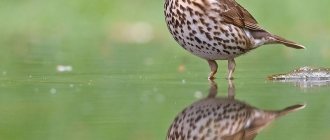Chameleon: what it looks like, description, structure, characteristics
These lizards are very interesting creatures. Their torso is completely covered with lumpy skin with small growths and thick areas. Some individuals have sharp horns, helmets, and small pearls near the eyes on their faces.
Chameleons prefer to climb trees. In the process of evolution, they remained with two and three toes on each paw. The fingers grow together into two groups opposite to each other. Each group has 2 toes on the front paws and 3 on the hind paws, looking like “claws”. At the tips of each finger there is one sharp claw, thanks to which lizards can safely climb, clinging to the bark. In addition to the paws, there is a tail, which chameleons also use in the process of climbing the trunk.
Chameleon paws
These lizards are the real kings of camouflage. They hide not only from their prey, but also from predatory animals. Chameleons are also famous for the fact that they can remain in one position for several days. In special cases, chameleons freeze for several weeks. This way the lizard lulls the vigilance of its prey and calmly attacks.
Chameleon disguise
Chameleons are practically invisible in thickets of plants. They can take on any color, masquerading as objects around them. If you look at a chameleon from the front, it will appear flat. Color changes occur due to the special structure of the skin, which is able to masquerade as the animal’s natural habitat.
Chameleon front
Character and lifestyle of a chameleon
Chameleons spend most of their time resting on tree branches. They can wait for prey or simply rest. Lizards descend only when it is time for the mating season. It is difficult for chameleons to move on the ground. Two-fingered limbs are better suited for climbing trees.
Chameleon on a tree
Thanks to their powerful tail, chameleons can feel calm in dense thickets. They always have something to cling to and somewhere to run away. Chameleons are active during the day and rarely move. When in danger they can run and jump extremely quickly. The danger comes from snakes, other lizards and birds. If an enemy notices a chameleon, it begins to inflate and change color. The reptile may bite a little, but cannot cause much harm. Chameleons' jaws are too weak.
Interesting: Birds that cannot fly - list, description, photos and videos
Many people want to have chameleons in their home or apartment. This is due to the fact that the animal is quite unpretentious and does not require special care. If you provide all the conditions necessary for the lizard, it will become your friend for many years. It is better to consult with experienced veterinarians regarding care.
Where do chameleons live?
Habitat of chameleons
Chameleons live in sub-Saharan African countries. They can also be found in Madagascar and adjacent islands. Some species live in Asian and Arab countries. They can be found less often in America in warm states.
Chameleons prefer tropical climates, savannas and foothills. It's the easiest place to hide from danger, and there's a lot of food there. Some species of animals adapt well to living in steppe zones.
Interesting fact : in warm countries, chameleons are kept indoors to catch flies. Chameleons can be found in Spanish homes and retail establishments.
How many types of chameleons live on Earth?
There are 193 species with a wide range of habitats . Madagascar is considered their homeland; now lizards are found in Africa, Southern Europe, the USA (Hawaii, Florida, California), India, Sri Lanka, the Middle East, Mauritius. The main part is adapted for living in trees, descending to the ground only for mating games or for very attractive prey. But there are also those that live in deserts and steppes, tropical forests and mountainous areas, digging holes or seeking refuge in fallen leaves.
IMPORTANT! Due to the expansion of agricultural land and deforestation, 10 species are threatened with extinction, and about 40 are close to receiving such status.
How does a chameleon change color?
Chameleon changes color
If you look at the skin of a chameleon in cross-section, you will notice that under the transparent layer of the epidermis there is a thick layer of dermis. Two layers are capable of reflecting the blue and violet spectrum. Around them are two more layers - one with yellow cells, and the other with brown ones.
It was found that the change in color occurs as a result of changes in temperature, lighting and even... the mood of the creature. And special cells called chromatophores are “to blame” for this. This Greek word literally means “color-bearing” (chroma - color, paint and phoros - carrier). Chromatophores are located both in the superficial (fibrous) and deeper layers of the chameleon’s skin and have a branched structure.
The mechanism of operation of these pigment cells is quite complex. It is directly related to the functioning of the reptile's nervous system. The cytoplasm of chromatophores contains pigments that determine the color of the chameleon's skin. They are black, yellow, reddish, dark brown. Pigment grains are not fixed in one place, but have the ability to move throughout the cell, then concentrating towards its ends. The number of these pigment grains in the chromatophores is also not the same: in one cell there are more of them, in another there are very few. Consequently, the coloring of the chameleon will be uneven because of this.
Interesting: The strangest animals in the world - list, names, descriptions, photos and videos
How does a chameleon change color?
When the chromatophore processes contract, pigment grains collect in the center of the cells, and the skin becomes whitish or yellow. And when grains of dark pigment collect in the branches of the cell, the skin becomes dark, and may even turn black.
Various shades are obtained by combining pigment grains of both layers - superficial and deep. The nature of the appearance of green tones is interesting: this occurs due to the refraction of rays in the outer layer, which contains many light-refracting crystals. Because of this, the color of a chameleon can quickly change: from light - through various bright types of orange, green, purple - to black. Moreover, it can change both along the entire length of the reptile’s body, and in individual stripes and spots.
Thanks to such a unique skin structure, chameleons can change their color down to the smallest detail. The entire body of the animal shimmers with a spectrum of shades. Due to their invisibility, chameleons can only be seen while moving. It is for this reason that lizards rarely move, preferring to stand and wait for prey. Some types of snails can move much faster than chameleons. Every movement seems to be made in slow motion - the chameleon tracks them and records them.
Why does a chameleon change color?
Scientists Brücke, P. Baer and Krukenberg also found that the reasons for the change in color of these reptiles can be both physiological and emotional in nature. The former include, in addition to those mentioned above, temperature, lighting, high humidity, as well as dehydration, hunger and pain; to the second - a feeling of fear, a state of aggression towards the enemy or during an unwanted meeting.
The same scientists came to the conclusion that the reptile's nervous system is the main mechanism that sets the pigment grains in the chromatophores in motion: from the central nervous system, an impulse is transmitted through the nerves to each chromatophore, causing their movement. An interesting discovery was that its eyes play a huge role in the change in color of a chameleon.
It was experimentally established that the ability to change skin color in this reptile will be lost if the optic nerve is damaged or its eyes are deprived. That is, the following chain can be traced: light, entering the eyes and sending signals through them, affects the nervous system, and the latter affects the chromatophores.
Experts, studying the phenomenon of a chameleon changing color, concluded that the central nervous system of a reptile contains two centers - automatic and volitional, and both of them are responsible for the change in color of the reptile. The first is “responsible” for the tone of the color change system and, in case of irritation, lightens the skin. In turn, the automatic center is dependent on the volitional center, which suppresses its first and, therefore, gives the opposite effect - the skin darkens.
Interesting:











